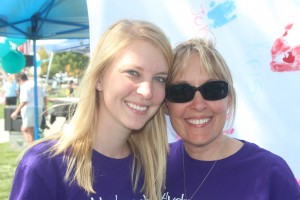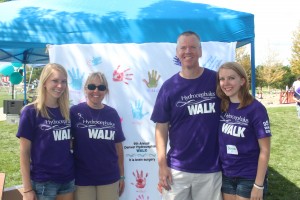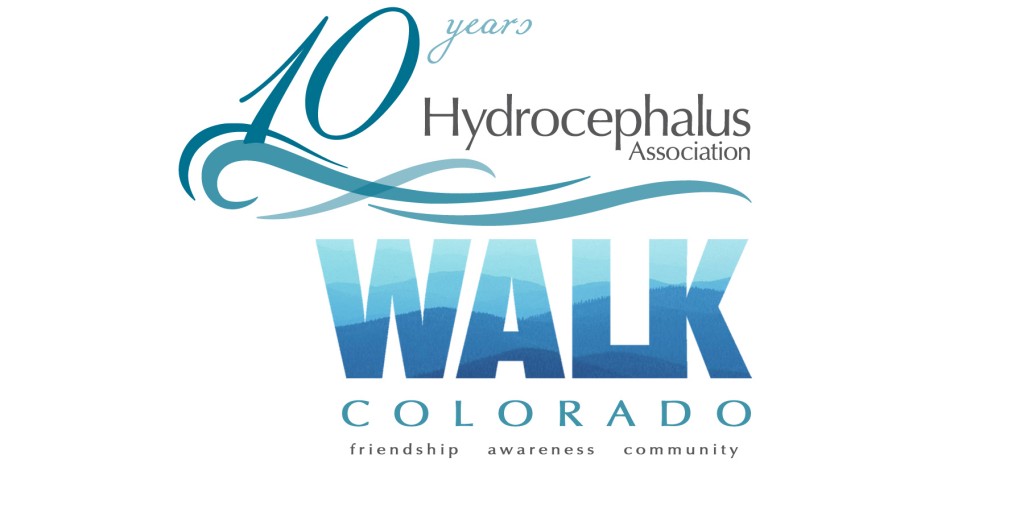Looking Back…Moving Forward: Celebrating 10 Years as a WALK Chair
 By Randi Corey, National Director of Special Events & Volunteer Support
By Randi Corey, National Director of Special Events & Volunteer Support
10 years ago, 60 people in Denver, Colorado, came together for Denver’s first WALK. As we continue our interview series in commemoration of our 30th anniversary, we sit down with Phyllis Rogers, who is in her 10th year chairing the Denver WALK – HA’s longest consecutive serving WALK Chair! Denver was our third WALK site after the original WALK site, San Francisco, followed by Richmond, Virginia. Phyllis reflects on her drive to continue to chair the WALK and her hopes for the future of the Hydrocephalus Association (HA).
HA: How did you find the HA and why did you decide to volunteer?
PHYLLIS: I don’t remember HOW I found the HA, but it probably was through either Children’s Memorial Hospital or Children’s Hospital Colorado in Denver. For the first few years of our daughter Jordan’s diagnosis, we thought hydrocephalus was just something we would have to deal with occasionally. After her initial shunt surgery she developed a shunt infection and then every year and a half she was undergoing revisions, beginning at age 4. Each of these episodes were “rote” and we just took it for granted that there would be shunt malfunctions every 18 months or so. At that time we didn’t understand the seriousness of shunt malfunction and surgery.
That view changed dramatically the summer of 2003. Jordan had a shunt revision on July 17th; six days later she was having headaches again so the neurosurgeon adjusted her programmable shunt value and sent us home. Of course, we ended up back at the neurosurgeon’s the next day and they determined her shunt wasn’t working. She was readmitted to the hospital for a shunt tap and a revision. During Jordan’s shunt surgery the lab informed the doctor that she had a shunt infection so her shunt was externalized. The next day she complained of a bad, bad headache and within a short time wasn’t verbally responding to us. Helplessly we watched her vitals go down. When we asked her how bad her headache was, all she did was flash both of her hands “five, five, five.” We called the nurse who tried to bring Jordan around, calling her name, telling her to open her eyes – then demanded they prepare an operating room immediately. A resident came in during the chaos and decided to “try something.” He releases the stitches holding the externalized catheter and wiggled it a bit – it pulled away from the side of her ventricle and immediately began to drain. Jordan opened her eyes and said “What the hell took so long?” (Yes, my ten-year old swore at me!) She told us she could hear us asking her to open her eyes but her brain wouldn’t let her.
Her shunt was internalized a week later only to malfunction the same day. The neurosurgeon, at that time, met with his entire staff, to determine the next steps – he added another catheter to her system, and 2 days later and a lot more gray hair, we finally went home!
I immediately called Pip at the HA and talked with her about our ordeal. This wasn’t the first time I reached out to Pip. Unfortunately, Jordan’s had a total of 19 surgeries in her 21 years, and many times we’ve had complications or unusual things happen. I always reached out to Pip. I can’t even tell you how much I appreciated the information and support she gave me over the years.
While reading the winter newsletter in early 2004, I noticed that there was a small ‘satellite’ walk on the east coast and I decided this was something I could do here in Colorado. I talked with our neighbors/friends who wanted to help. I contacted Pip (again), and 10 years later, here we are – same committee, too!
I organize this WALK to be proactive in my efforts to deal with this condition. I organize it for the HA because I will never be able to repay them for the support they’ve provided to my family and countless others over the past 21 years.
HA: What do you think HA WALKs do for the hydrocephalus community?
PHYLLIS: Provide an opportunity for families to get together and feel a sense of community. Until we held our first WALK, I didn’t know anyone else with hydrocephalus. There was no one locally to talk with, no other parents to lean on. Holding WALKs gives us the opportunity to network with one another and gives us another outlet to share our stories, ask questions, etc. We are no longer alone in our journey. Having shunt reps present at the event is also invaluable – when we’re in the emergency room with our doctor, there’s no time to ask questions, but when we’re at our WALK, we have all the time in the world to learn about shunts and how they work.
HA: What do you like best about leading a HA WALK — and what do you like the least?
PHYLLIS: The best part is watching hundreds of people gather at the park, knowing we’re all ‘in this together’; seeing the smiles on their faces, having them thank our committee for putting the event together. I always take a minute or two out of the morning to stand still and just watch the participants…it’s an unbelievable feeling! My least favorite part, like most others, would be securing food donations and all the paperwork and unforeseen complications which arise every year throughout the planning process. You’d think by now everything would run smoothly, but that’s not always the case!
HA: How does Jordan feel about your serving as a WALK Chair?
PHYLLIS: She says she’s proud of me – tells all her friends how much work is involved and how busy I am – even 6 months prior to WALK day.
 HA: The hours you spend on coordinating the WALK and all of your hard work for HA often require sacrifices on the part of your family members. How do they feel about your serving as a WALK Chair? Do they help with the WALK and if so, how?
HA: The hours you spend on coordinating the WALK and all of your hard work for HA often require sacrifices on the part of your family members. How do they feel about your serving as a WALK Chair? Do they help with the WALK and if so, how?
PHYLLIS: They help. They even say they like it, although I don’t believe them. In fact, they are part of our committee! They also spend countless hours planning the event. I don’t do this alone. I have a great group of family and friends who pull together to make it happen year after year.
HA: What is your favorite WALK moment or memory?
PHYLLIS: I’ll never forget the very FIRST WALK when Marty, one of our committee members, came to me to give me the grand total of monies raised. I was overcome with emotion and cried – no big shock for those who know me. You have to remember, this event was held by word-of-mouth only. There wasn’t much administrative support from the corporate office – no online registration or fundraising tools, no blast emails, no FedEx Office to handle printed materials. I thought we’d be lucky to raise $1,000 and we ended up at $6,000, with only 60 of us attending. It’s a moment I’ll never forget.
HA: Where would you like to see HA 5 years from now?
PHYLLIS: I’d love to see them continue as the leader in providing support, education and research for hydrocephalus. I’d like every family dealing with hydrocephalus to know the Association exists. In 5 years, 100 percent of WALK proceeds will go toward research.
HA: What message do you have for the HA staff?
PHYLLIS: I can’t thank the staff and Medical Advisory Board enough for the personal support and educational resources they’ve given me. Knowing the Association is available if needed is a huge comfort. I’ve learned more from talking with the staff than I ever could have learned by reading and searching the internet. The staff is an invaluable resource to our families.
HA: What message do you have for the HA Board of Directors?
PHYLLIS: We need to get the HA recognized as, not only the largest non-profit funder of hydrocephalus research, but also as the leader of support and education for hydrocephalus. I can’t believe the number of people I meet at the WALK who don’t know about the HA – they get their information from their doctors, and many of them aren’t members of the HA, even after attending a WALK.

